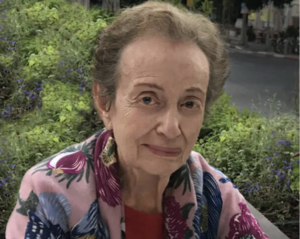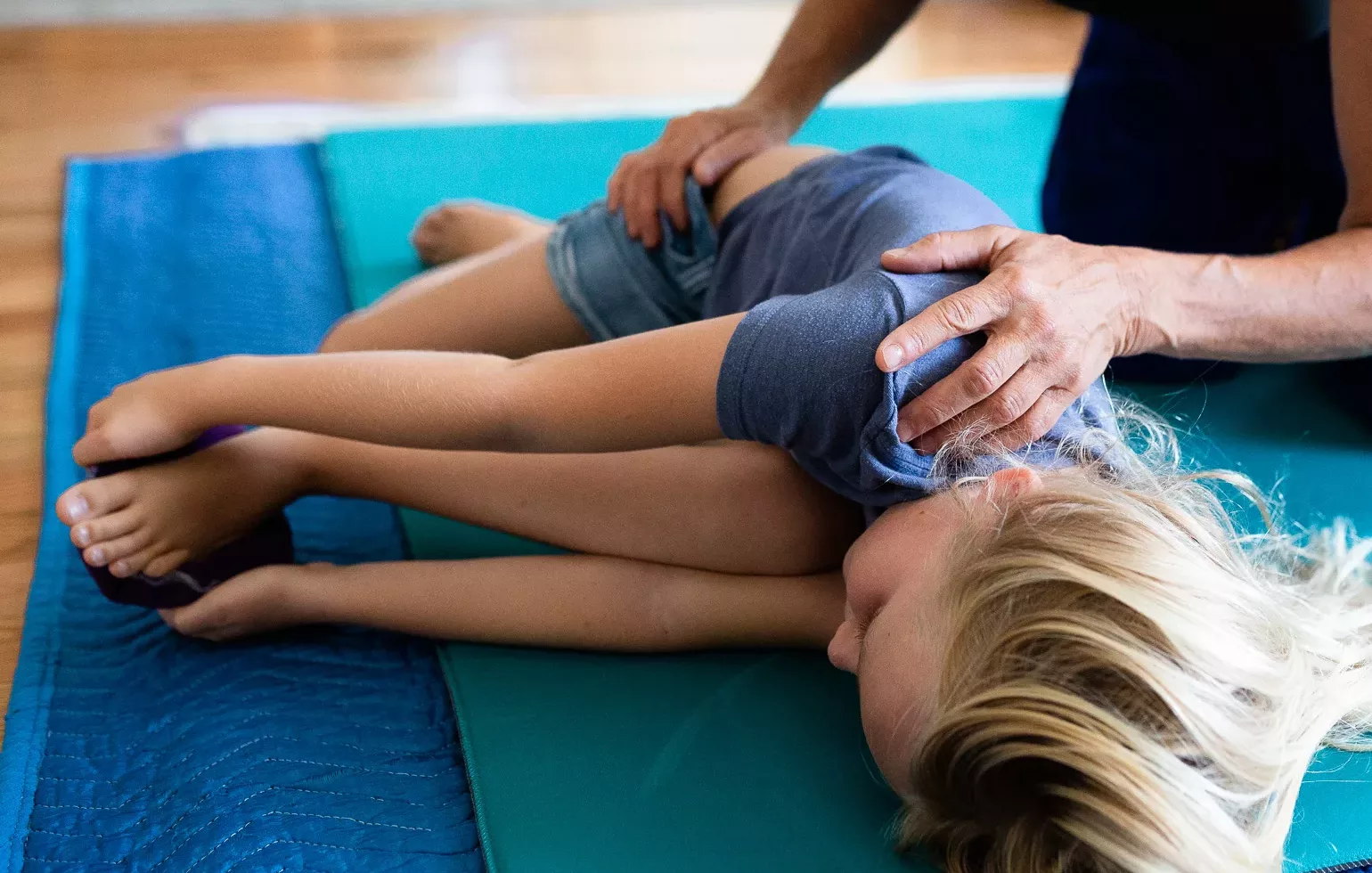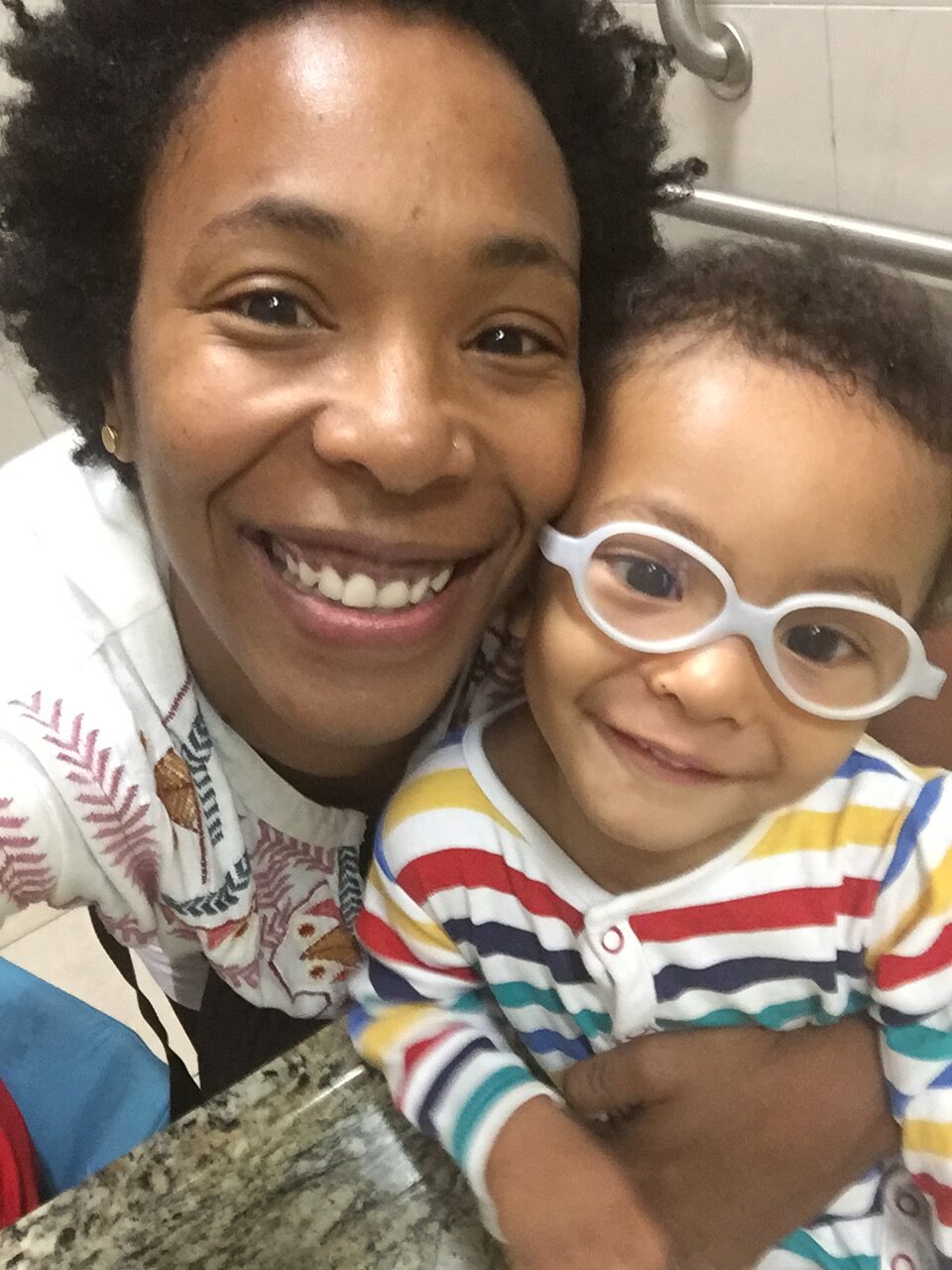



Pati Holman has been a practitioner for 30 years. She works with a full range of diagnoses: from acute injury rehabilitation to complex neurological challenges. While her practice is in Ashland, Oregon, she works with adults and children in settings all around the world. Driven by the desire to inspire children and families to tap into their infinite capacity to learn and improve, Pati used the years of the lockdown to deepen her understanding of the work. She continues to be inspired by the Amherst videos as fundamental source material. Learn more about Pati’s work at her website www.mindmovinglearning.com.
I chose the title for this interview based on how Pati Holman shows up: her conviction in the importance of the Feldenkrais Method comes across with such clarity that anyone who meets her would be impressed with its efficacy.
Gabrielle Pullen: The Feldenkrais method has such broad applications. Lately, because of course the world has changed and how we do things has changed. What do you have in the works?
Patricia Holman: Thank you for asking! I have a workshop coming up for adults in April, as well as a Free Children’s Clinic. It’s an opportunity for parents to bring their children in for a 30 minute lesson.
GP: There was a little discussion in a recent meeting with FGNA members about if it is appropriate to offer free things and there were different opinions about that. But I think it’s appropriate to give people a taste and to make them curious.
PH: As a way to promote my practice, I do offer my services free from time to time. Especially for new practitioners, I think offering free movement lessons or classes is a great strategy. It makes sense to reach out to fellow practitioners and complementary practitioners: people like vision therapists, neurologists, or pediatricians. I sometimes offer free sessions to those people in my network if I know it’s a good fit. I think that people need to be able to experience the work.
GP: Personally, I think that now is a time when Feldenkrais is needed more than ever because we’ve spent these last three years being disembodied; only being able to see each other on videos or zoom. So, if we’re about helping people become embodied, the relevance of the Method has increased. Do you also see Feldenkrais as more relevant than ever before?
PH: You know, I’ve always felt that way. I’ve always felt that the time is now for this work, and that’s maybe why I’m still doing it after 32 years. Something that’s perhaps new since I started my practice is that trauma might have been a topic of conversation in circles of specialty, but now the discussion about trauma informed therapy seems to be everywhere. Attention to this is important when you’re working with people with all the range of issues. I think Feldenkrais is relevant for everyone, always.
GP: Do you agree that perhaps people have experienced some kind of change in identity based on the deprivation caused by lockdowns, masking, social distancing and the difficulties people have endured as an unintended consequence of the pandemic?
PH: The work itself, as Ruthy Alon says, is one of biological optimism. Yet, at the same time, Feldenkrais developed the work around an understanding of the body pattern of anxiety. I know that seems very monotone. But it really covers a broad range, the body pattern of anxiety, whether it’s trauma induced or from some acute experience. We’re always looking at the body pattern of anxiety. On my intake form, I ask about any history of trauma. People will tell me, but often they don’t – if there’s been abuse in the past or alcoholism in the family, or incest, all of these things…I assume that each person’s story is going to contain some kind of trauma. And so I hold an emotional container for it, because I myself have done a lot of shadow work and I understand the importance of acknowledging it. And when you work from the fundamental awareness that the body is not separate from the anxiety, the emotion, the trauma, then there’s no debate that the method is inherently trauma based. The work carries within its principles and application, the operational tools to address it.
GP: Feldenkrais spoke about self image as being affected by the environment that we’re living in, and that it fluctuates and changes.
PH: Let’s talk about Moshe’s history. He grew up in the Ukraine. During the pogroms, his family’s way of life was under assault. His extended family’s way of life was under assault. There was violence, there was death and that is completely analogous to the current era. So, where did he go? He emigrated to Palestine as a young person of 14. Making this arduous and dangerous journey at such a young age says a lot about Moshe and his intensity. And from Palestine he went to Paris for his doctorate. And then another World War begins at his feet and because of his Jewish identity, he escapes Paris to Britain, with another dangerous & harrowing departure. He spent the war years in a Scottish port working for the British Admiralty. An odd juxtaposition to say the least! Then, back to the ‘new’ Israel. To me, this is an extraordinary effort! That so creative a work emerged fully expressed, in spite of it being formed from the soil of tyranny. What an exemplary lesson in resiliency.
His particular way of seeing things is comprehensive, as well as the accomplishment of bringing together the best minds of the previous generations and of his generation to form this very unique therapy or educational system. Feldenkrais was highly creative, and skilled, obviously intelligent but creative. And he never stopped in his in his pursuit of this system, which from a deep internal wisdom, that it needed to be manifested. I think that for me, as a Feldenkrais practitioner, when the tyranny came down on us: “do this, don’t do or say that”, stop practicing in person and go online, losing medical freedoms, or, the states decision to close health facilities, being told my business was nonessential, —-all these dictates, I said, “No. This is an essential business. What I do is an essential business. Not only is it essential for the people who come to me for lessons, but it’s essential for me, in my own wellbeing to continue to practice in person. It’s an essential service.”
GP: It’s certainly essential to me in my wellbeing, why wouldn’t it be essential to the public?
PH: And to practitioners in the NW Region, I want to say, the work will die if we do not do it in
person. It has to be conveyed through the hands, through the spirit, the soul of the person, and this is the essence of Moshe Feldenkrais. We are human beings. Creative human beings in relation to one another. And if we go to an online format, we have taken out the potency of the work. Then it becomes just another thing that you can get online. Is that what we really want to do? No, we want to uphold the method’s potency. So, I think we need more people, like myself and you, Gabrielle, to say, “No, we are not going to stop practicing. We are an essential business. I can’t speak for you, but I’m only going to practice in person.” And that’s what I insisted on.
GP: That certainly speaks to a high level of personal integrity which has been challenged by these past three years. That’s why I believe we need to have a more cohesive region where we as practitioners support each other. How did it work out?
PH: During that period, I did lose some clients. But who didn’t? I used that time as an
opportunity to study more. I used it as an opportunity to work on my website, to do those, let’s say, soft things about my business that lead to more business. I spent time deepening my competency. You see it gave me an opportunity to really dig deeper about why I do the work. It gave me an opportunity to study more. And to read deeply into the biography by Mark Reese, “Moshe Feldenkrais: A Life in Movement”. I continued diving into the Amherst videos that I began in earnest in 2016. I think they are one of the best resources for Feldenkrais practitioners. I was motivated to begin studying them when online Amherst study groups were more numerous, and I found a group to join in with. I participated in group study for 1/2 of the first year of Amherst, and then decided that self-study was more beneficial for me, as the online format was not conducive to nuanced communication. And, I started writing more, which is something that’s always a challenge for
me!
GP: Yes, well, writing, like walking, is something everyone can do, but writing also benefits
from a process of intentional awareness for a time. It’s effective because, like Feldenkrais, it
completes a feedback loop, which is why it also improves learning how to learn more
effectively. I so appreciate your willingness to sit down and discuss these important issues and I appreciate how deeply you think about them! Pati, thank you so much for this wonderful
interview!
__________________________________________________
References
1. The Body and Mature Behavior: A Study of Anxiety, Sex, Gravitation, and Learning, by
Moshe Feldenkrais
2. Image, Movement, and Actor: Restoration of Potentiality by Moshe Feldenkrais, translated
and edited by Kelly Morris (Collected Articles & Interviews with Moshe Feldenkrais, D. Sc.)
__________________________________________________

You’ve heard this phrase a hundred times before no doubt, and you understand what’s implied here. Anything goes. It’s all good. You’re free to choose anything. Be as crazy, or as sane or spontaneous as you want. Try anything. Trust your will to a goal. There’s no wrong way, there are no mistakes. One hears this famous Feldenkrais quote not infrequently, and usually in the environment of a movement lesson exploration. I always chuckle when I hear it.
But what does Moshe really mean when he makes this request?
The effort involved in “doing any damn thing you want” is predictably excessive, habitual and ill-fitted to the stimulus that set it off. Like a deep groove or well-travelled trail, there is no requirement for exploration or novelty or authentic and organic freedom of thought or action. Doing any damn thing you want produces ironically the opposite, a deeply grooved pattern of action, unoriginal and deeply conditioned.
My professional life is devoted to helping others find greater comfort, vitality and reduced anxiety through the methodology of the somatic philosopher & martial artist, Moshe Feldenkrais. One of the myriad ways I practice and embody the philosophy he developed is to study videotaped trainings he taught in the United States during the mid 1970’s to early 1980’s.
Dr. Feldenkrais gives us 3 key inherent principles basic to any movement. These are neuromuscular organization, timing and orientation. When we attend to movement and offer novelty and variation within a structured movement exploration, then new learning occurs.
Say, for example sitting in your chair as you read this, that you want to be more comfortable. Do anything to accomplish greater comfort.
Go ahead! Be curious, what did you do to make yourself more comfortable? Can you express it nonverbally or out loud doesn’t matter, how you make yourself more comfortable? Listen to yourself…, that’s right. Give your self some time to experience how you did the thing to make yourself more comfortable.
Okay, now let that go for a moment.
Okay, now, let’s move with intention and awareness:
Return to your chair sitting away from the chair back, move back and return from the middle to the right side sitz bone. Right, and return middle to right and back to middle. Many times. Make it easy, make it comfortable. Keep going. What is your head doing? Where does it go? Can you express what is happening in the movement of your head when you rock to the right sitz bone? How does your spine move when you rock to the right side? How does it bend, flex, or arch? What is happening there? Can you express in words or images what you sense and observe?
Now go to the left sitz bone, rock leftwards and return to middle, slowly, many times. Make it easy, make it comfortable. Keep going. What is your head doing? Where does it go? Can you express what is happening in the movement of your head when you rock to the left side sitz bone? How does your spine move when you rock to the left side? How does it bend, flex, or arch? What is happening there? Can you express in words or images what you sense and observe?
Let’s go in another direction. Move and shift your weight to your pubic bone, so arrange yourself so that from where you’re sitting on yourselves, you shift your weight to your pubic bone. Many times. Make it easy, make it comfortable. Keep going. What is your head doing? Where does it go? Can you express what is happening in the movement of your head when you rock to your pubic bone? How does your spine move when you rock forwards like this? How does it bend, flex, or arch? What is happening there? Can you express in words or images what you sense and observe?
And now shift weight to your tailbone, many times.
Make it easy, make it comfortable. Keep going. What is your head doing? Where does it go? Can you express what is happening in the movement of your head when you rock to your tailbone? How does your spine move when you rock here? How does it bend, flex, or arch? What is happening there? Can you express in words or images what you sense and observe?
Okay, that’s it. rest yourself. Close your eyes if you want, and rest, breathe.
For one last time, go ahead! Sense how you make yourself more comfortable in sitting.
Go ahead, do any damn thing you want!
Can you more deeply sense and observe how the freedom to move is actually more informed and with a deeper integrity now that you’ve paid attention to yourself in this way? How do you sense this freedom in yourself? What has changed?
And this was Moshe’s exemplary & loving guidance
Disengaging from habitual patterns is necessary for learning. When you know what you’re doing, and have a clearer knowledge of self and ability, you reduce the effort of the will & release habitual thought & action.
Then, you can do any damn thing you want!

Adults & the parents of children that choose the Feldenkrais Method or the Anat Baniel Method for Children, choose the principle that connecting with what is rather than correcting what’s wrong, is the first step in novel learning and overcoming limitation .Combined with the other brain-based learning tools, there’s more potency in any action that that comes from discovering for oneself how to shift from pain and limitation to possibility; creatively & dynamically problem solving; using the incredible and elegant power of the human brain to learn something new.
The current widely held therapeutic model is basically this: Exercise, or force the child into the milestone that isn’t currently there, practice it a lot, add in tears, pain, resistance, willpower, & coercion, and it will be hard-wired. Functional outcomes will be hard-won in the short term and the potential for neurotic, compulsive behavior that develops from force, coercion and ‘not-being-met’ will pattern ineffective and dysfunctional patterns.
I operate from an entirely different working hypothesis. When the brain can become a better learner, then function will follow. Improved thinking, coupled with present moment awareness is the first step to more organized function. I help children overcome limitation using the Nine essentials to prime the nervous system. When I set the table using the Nine Essentials, then other developmental steps can emerge. Not only do these milestones have a better chance of emerging organically, but they emerge with with less effort, more joy, more natural curiosity, more power & potency to last a lifetime.
The best therapy is the one that honors self-empowerment, & the current abilities of the child rather than the limitation. It honors self-paced learning rather than standardized milestones. It honors & recognizes that the best learning comes when your child is being “met”.